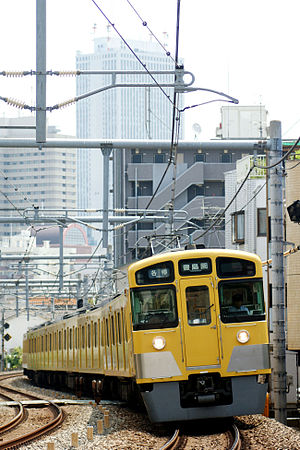Seibu Ikebukuro Line
| Seibu Ikebukuro Line | |
|---|---|

Seibu 2000 series near Ikebukuro Station, June 2008
|
|
| Overview | |
| Native name | 西武池袋線 |
| Locale | Kanto region |
| Termini |
Ikebukuro Agano |
| Stations | 31 |
| Daily ridership | 892,025 (2010) |
| Operation | |
| Opened | 15 April 1915 |
| Owner | Seibu Railway |
| Depot(s) | Kotesashi |
| Technical | |
| Line length | 57.8 km (35.9 mi) |
| Track gauge | 1,067 mm (3 ft 6 in) |
| Minimum radius | 200 m |
| Electrification | 1,500 V DC, overhead catenary |
| Operating speed | 120 km/h (75 mph) |
The Seibu Ikebukuro Line (西武池袋線 Seibu Ikebukuro-sen?) is a railway line of the Japanese private railway operator Seibu Railway. It originates at Ikebukuro Station, a large railway junction in north-western Tokyo, extending to northwest suburbs as far as Tokorozawa, Saitama, and nominally terminates at Agano Station.
The Seibu Chichibu Line from Agano to Seibu Chichibu Station is an extension. The operation is largely divided into two sections: from Ikebukuro to Hannō Station and from Hannō to Seibu Chichibu Station.
The Ikebukuro Line has three branches with through operation, apart from the Seibu Chichibu Line.
Tracks:
Abbreviations here are for the table below, not formally used.
Local services are not shown.
A fleet of eight 10-car Seibu 40000 series EMUs is scheduled to be introduced from spring 2017, operating on the Seibu Ikebukuro, Seibu Shinjuku, and Seibu Haijima Lines.
The line opened 15 April 1915 as the Musashino Line (武蔵野線 Musashino-sen?) (separate from the Musashino Line currently operated by JR East), by the then Musashino Railway (武蔵野鉄道 Musashino Tetsudō?), the predecessor of the present Seibu Railway with the first section from Ikebukuro to Hannō. In 1922, electrification began in three stages from Ikebukuro, until reaching Hannō in 1925. In the late 1920s, a second track was added from Ikebukuro to Hōya Station, and in 1929 the line was extended to Agano Station, the present nominal end. On March 25, 1952, the line was renamed to the Ikebukuro line, and throughout the 1950s and 1960s, the 2-track section was extended in stages until reaching Kasanui yard in 1969.
...
Wikipedia
